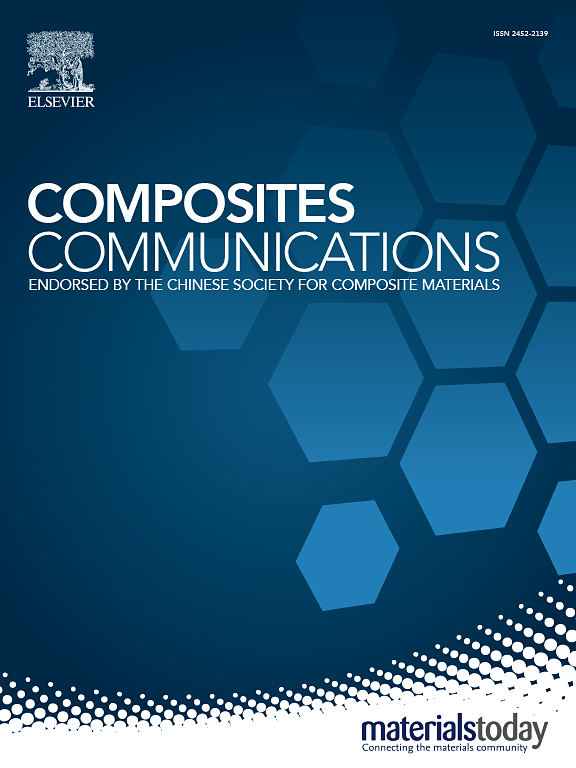添加石墨烯对多晶铜电性能影响的计算研究
IF 7.7
2区 材料科学
Q1 MATERIALS SCIENCE, COMPOSITES
引用次数: 0
摘要
最近,石墨烯的添加已显示出显著改善金属材料体电性能的前景。我们探讨了石墨烯的添加对铜-石墨烯(Cu-Gr)纳米复合材料净电导率的影响,并将其视为晶粒结构和晶界特性的函数。生成的合成三维微结构代表了具有不同平均晶粒直径和孪生晶界分数的多晶铜。然后,使用有限差分法求解了电气传输的泊松方程,以预测每种微结构的净电导率。在这种情况下,石墨烯对复合材料电导率的潜在影响被评估为受影响晶界数量的函数。这些计算的结果表明:1.) 正如文献所证实的,净电导率会随着晶粒尺寸的减小而降低;2.) 晶界孪晶的存在会导致电导率的损失比预期的要小;3.然而,我们还发现 4.) 当铜晶粒结构变得足够精细时,可以想象石墨烯的加入会使导电性比粗晶粒铜有显著改善。根据我们的计算估计,假设微结构的平均晶粒大小在 100 纳米到 100 微米之间,而石墨烯的电导率是典型铜晶界的 1000 到 10,000 倍,那么与块状铜相比,电导率可提高约 17%。因此,通过这项研究,我们提出了一条通过添加石墨烯改善铜电性能的可行途径。本文章由计算机程序翻译,如有差异,请以英文原文为准。
A computational study of the effects of graphene additions on electrical properties of polycrystalline copper
The addition of graphene has recently shown promise as a route for the significant improvement of the bulk electrical properties of metallic materials. We explore the effects these additions have on the net electrical conductivity of fabricated copper-graphene (Cu-Gr) nanocomposites as a function of grain structure and grain boundary properties. Synthetic 3D microstructures were generated to represent polycrystalline copper with different average grain diameters and twinned grain boundary fractions. Then, the Poisson equation of electrical transport was solved using a finite difference method in order to predict the net electrical conductivity of each microstructure. In this context, the potential effect of graphene on the conductivity of the composite was evaluated as a function of the number of affected grain boundaries. The results of these calculations indicate that 1.) as supported by literature, net electrical conductivity decreases with decreasing grain size, 2.) the presence of twinned grain boundaries results in smaller loss of conductivity than would otherwise be expected, and 3.) the presence of graphene on the grain boundaries can be expected to lead to improvements in net electrical conductivity. However, we also find that 4.) when the Cu grain structure becomes sufficiently refined, the addition of graphene could conceivably result in significant improvements in electrical conductivity over and above coarse-grained Cu. It is estimated from our calculations that, assuming microstructures with average grain sizes between 100 nm and 100 μm and graphene conductivity 1000 to 10,000 that of a typical Cu grain boundary, an improvement in electrical conductivity of approximately 17 % over that of bulk Cu may be attainable. Therefore, by performing this study we suggest a possible route for the improvement of Cu electrical properties through the addition of graphene.
求助全文
通过发布文献求助,成功后即可免费获取论文全文。
去求助
来源期刊

Composites Communications
Materials Science-Ceramics and Composites
CiteScore
12.10
自引率
10.00%
发文量
340
审稿时长
36 days
期刊介绍:
Composites Communications (Compos. Commun.) is a peer-reviewed journal publishing short communications and letters on the latest advances in composites science and technology. With a rapid review and publication process, its goal is to disseminate new knowledge promptly within the composites community. The journal welcomes manuscripts presenting creative concepts and new findings in design, state-of-the-art approaches in processing, synthesis, characterization, and mechanics modeling. In addition to traditional fiber-/particulate-reinforced engineering composites, it encourages submissions on composites with exceptional physical, mechanical, and fracture properties, as well as those with unique functions and significant application potential. This includes biomimetic and bio-inspired composites for biomedical applications, functional nano-composites for thermal management and energy applications, and composites designed for extreme service environments.
 求助内容:
求助内容: 应助结果提醒方式:
应助结果提醒方式:


